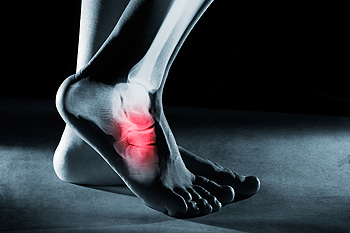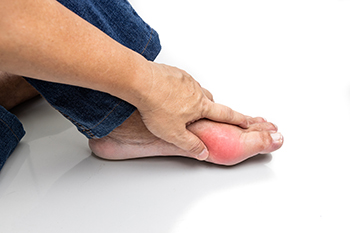July 2024
Causes and Sensations of Foot Stress Fractures

A foot stress fracture manifests as a small crack or severe bruising within a bone, typically caused by repetitive force or overuse, such as high-impact activities like running or jumping. This injury often results from sudden increases in activity intensity or duration, wearing inadequate footwear support, or changes in training surfaces. Symptoms can include localized pain and tenderness, swelling, and difficulty bearing weight on the affected foot. The pain associated with a stress fracture is often described as dull and achy initially, worsening with activity and subsiding with rest. In some cases, there may be a noticeable tenderness or throbbing sensation at the fracture site. Prompt diagnosis through imaging techniques like X-rays or MRI scans is essential to differentiate a stress fracture from other foot injuries and initiate appropriate treatment. If you have foot pain, and believe it may be a stress fracture, it is suggested that you visit a podiatrist who can determine what the most appropriate course of treatment is for you.
Stress fractures occur when there is a tiny crack within a bone. To learn more, contact Dr. Stephen Petrofsky from Florida. Our doctor can provide the care you need to keep you pain free and on your feet.
How Are They Caused?
Stress fractures are the result of repetitive force being placed on the bone. Since the lower leg and feet often carry most of the body’s weight, stress fractures are likely to occur in these areas. If you rush into a new exercise, you are more likely to develop a stress fracture since you are starting too much, too soon. Pain resulting from stress fractures may go unnoticed at first, however it may start to worsen over time.
Risk Factors
- Gender – They are more commonly found in women compared to men.
- Foot Problems – People with unusual arches in their feet are more likely to develop stress fractures.
- Certain Sports – Dancers, gymnasts, tennis players, runners, and basketball players are more likely to develop stress fractures.
- Lack of Nutrients – A lack of vitamin D and calcium may weaken the bones and make you more prone to stress fractures
- Weak Bones – Osteoporosis can weaken the bones therefore resulting in stress fractures
Stress fractures do not always heal properly, so it is important that you seek help from a podiatrist if you suspect you may have one. Ignoring your stress fracture may cause it to worsen, and you may develop chronic pain as well as additional fractures.
If you have any questions, please feel free to contact our office located in Port Charlotte, FL . We offer the newest diagnostic and treatment technologies for all your foot care needs.
When Should Babies Start Wearing Shoes?

Babies do not need shoes until they begin walking outdoors. Until then, crawling or walking barefoot and wearing socks can help the feet to grow and strengthen naturally. Putting shoes on too early can impede proper foot development while restricting movement and growth. When the time is right to choose baby shoes, opt for soft, flexible soles that mimic natural foot motion, allowing toes to grip and flex. Ensure a wide toe box for ample space and breathable materials for comfort. Proper fit is essential, as shoes should be neither too tight nor too loose to prevent blisters and ensure stability. Regularly check for signs of wear and outgrowth to maintain the best support. If you notice any abnormalities concerning your child’s feet, it is suggested that you consult a podiatrist who can treat any foot condition and guide you on proper shoe selection.
Making sure that your children maintain good foot health is very important as they grow. If you have any questions, contact Dr. Stephen Petrofsky of Florida. Our doctor can provide the care you need to keep you pain-free and on your feet.
Keeping Children's Feet Healthy
Having healthy feet during childhood can help prevent medical problems later in life, namely in the back and legs. As children grow, their feet require different types of care. Here are some things to consider...
Although babies do not walk yet, it is still very important to take care of their feet.
Avoid putting tight shoes or socks on his or her feet.
Allow the baby to stretch and kick his or her feet to feel comfortable.
As a toddler, kids are now on the move and begin to develop differently. At this age, toddlers are getting a feel for walking, so don’t be alarmed if your toddler is unsteady or ‘walks funny’.
As your child gets older, it is important to teach them how to take care of their feet.
Show them proper hygiene to prevent infections such as fungus.
Be watchful for any pain or injury.
Have all injuries checked by a doctor as soon as possible.
Comfortable, protective shoes should always be worn, especially at play.
If you have any questions please feel free to contact our office located in Port Charlotte, FL . We offer the newest diagnostic and treatment technologies for all your foot and ankle needs.
Understanding the Impact of Diabetes on the Feet

Diabetes significantly affects foot health due to the condition's influence on circulation and nerve function. Poor blood flow, a common complication, hinders the healing process and increases the risk of infections. Nerve damage, or neuropathy, reduces sensation in the feet, making it difficult to notice injuries or pressure sores. These issues can escalate to serious infections or ulcers if left untreated, potentially leading to amputations. Maintaining proper foot care and regular check-ups are essential for individuals with diabetes to prevent severe complications. Simple practices, such as daily inspections for cuts or blisters and wearing appropriate footwear, can make a substantial positive difference. Overall, understanding the connection between diabetes and foot health is important in managing the condition and preventing debilitating outcomes. If you have diabetes, it is strongly suggested that you are under the care of a podiatrist who can help you manage this serious condition.
Diabetic foot care is important in preventing foot ailments such as ulcers. If you are suffering from diabetes or have any other concerns about your feet, contact Dr. Stephen Petrofsky from Florida. Our doctor can provide the care you need to keep you pain-free and on your feet.
Diabetic Foot Care
Diabetes affects millions of people every year. The condition can damage blood vessels in many parts of the body, especially the feet. Because of this, taking care of your feet is essential if you have diabetes, and having a podiatrist help monitor your foot health is highly recommended.
The Importance of Caring for Your Feet
- Routinely inspect your feet for bruises or sores.
- Wear socks that fit your feet comfortably.
- Wear comfortable shoes that provide adequate support.
Patients with diabetes should have their doctor monitor their blood levels, as blood sugar levels play such a huge role in diabetic care. Monitoring these levels on a regular basis is highly advised.
It is always best to inform your healthcare professional of any concerns you may have regarding your feet, especially for diabetic patients. Early treatment and routine foot examinations are keys to maintaining proper health, especially because severe complications can arise if proper treatment is not applied.
If you have any questions please feel free to contact our office located in Port Charlotte, FL . We offer the newest diagnostic and treatment technologies for all your foot and ankle needs.
Wounds That Don't Heal Need to Be Checked
How to Tell if You Have Gout

Gout is a type of arthritis characterized by sudden, severe attacks of pain, redness, and tenderness in joints, often the big toe. Recognizing the symptoms of gout can be straightforward when experiencing intense, painful swelling in a single joint that subsides and reappears, sometimes in different joints. However, pinpointing gout can be challenging if symptoms are less typical. A podiatrist can provide a definitive diagnosis through various tests. Lab tests for gout measure uric acid levels in the blood and joint fluid analysis to detect uric acid crystals. Imaging tests like X-rays, ultrasounds, and other types of scans can help rule out other conditions and identify joint damage or uric acid crystal deposits. Post-diagnosis, ongoing monitoring through blood tests ensures that uric acid levels remain controlled, preventing further attacks and complications. These tests, coupled with a podiatrist's expertise and certain pain relief medications, help manage and treat gout effectively. If you are experiencing symptoms of gout, it is suggested that you make an appointment with a podiatrist for an exam, diagnosis, and treatment options.
Gout is a foot condition that requires certain treatment and care. If you are seeking treatment, contact Dr. Stephen Petrofsky from Florida. Our doctor will treat your foot and ankle needs.
What Is Gout?
Gout is a type of arthritis caused by a buildup of uric acid in the bloodstream. It often develops in the foot, especially the big toe area, although it can manifest in other parts of the body as well. Gout can make walking and standing very painful and is especially common in diabetics and the obese.
People typically get gout because of a poor diet. Genetic predisposition is also a factor. The children of parents who have had gout frequently have a chance of developing it themselves.
Gout can easily be identified by redness and inflammation of the big toe and the surrounding areas of the foot. Other symptoms include extreme fatigue, joint pain, and running high fevers. Sometimes corticosteroid drugs can be prescribed to treat gout, but the best way to combat this disease is to get more exercise and eat a better diet.
If you have any questions please feel free to contact our office located in Port Charlotte, FL . We offer the newest diagnostic and treatment technologies for all your foot and ankle needs.
Treatment for Sever’s Disease
 Sever's disease, also known as calcaneal apophysitis, is a common cause of heel pain in growing children and adolescents, particularly those involved in sports. It occurs when the growth plate in the heel becomes inflamed due to repetitive stress and overuse. This condition typically affects children between the ages of eight and 14, coinciding with periods of rapid growth. Patients with calcaneal apophysitis often experience pain and tenderness in the heel, which can worsen with physical activity and improve with rest. The pain is usually located at the back of the heel and can be accompanied by swelling and difficulty while walking. Treatment focuses on reducing pain and inflammation, and rest is commonly suggested. Stretching exercises, wearing proper footwear, and orthotic inserts can also help to alleviate symptoms. If your child is complaining of heel pain that persists, it is suggested that you visit a podiatrist for a thorough evaluation and tailored treatment plan.
Sever's disease, also known as calcaneal apophysitis, is a common cause of heel pain in growing children and adolescents, particularly those involved in sports. It occurs when the growth plate in the heel becomes inflamed due to repetitive stress and overuse. This condition typically affects children between the ages of eight and 14, coinciding with periods of rapid growth. Patients with calcaneal apophysitis often experience pain and tenderness in the heel, which can worsen with physical activity and improve with rest. The pain is usually located at the back of the heel and can be accompanied by swelling and difficulty while walking. Treatment focuses on reducing pain and inflammation, and rest is commonly suggested. Stretching exercises, wearing proper footwear, and orthotic inserts can also help to alleviate symptoms. If your child is complaining of heel pain that persists, it is suggested that you visit a podiatrist for a thorough evaluation and tailored treatment plan.
Sever's disease often occurs in children and teens. If your child is experiencing foot or ankle pain, see Dr. Stephen Petrofsky from Florida. Our doctor can treat your child’s foot and ankle needs.
Sever’s Disease
Sever’s disease is also known as calcaneal apophysitis, which is a medical condition that causes heel pain I none or both feet. The disease is known to affect children between the ages of 8 and 14.
Sever’s disease occurs when part of the child’s heel known as the growth plate (calcaneal epiphysis) is attached to the Achilles tendon. This area can suffer injury when the muscles and tendons of the growing foot do not keep pace with bone growth. Therefore, the constant pain which one experiences at the back of the heel will make the child unable to put any weight on the heel. The child is then forced to walk on their toes.
Symptoms
Acute pain – Pain associated with Sever’s disease is usually felt in the heel when the child engages in physical activity such as walking, jumping and or running.
Highly active – Children who are very active are among the most susceptible in experiencing Sever’s disease, because of the stress and tension placed on their feet.
If you have any questions, please feel free to contact our office located in Port Charlotte, FL . We offer the newest diagnostic and treatment technologies for all your foot and ankle injuries.









